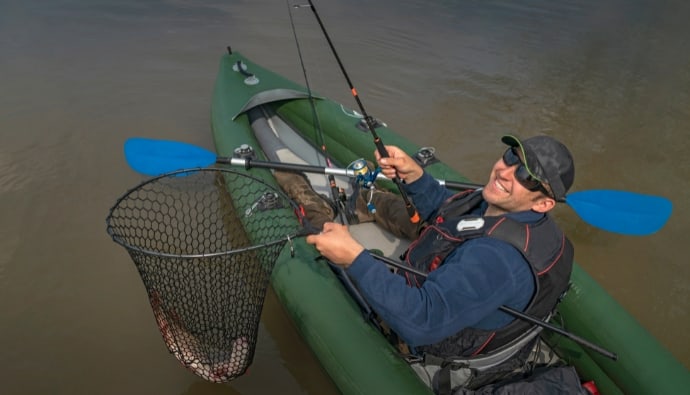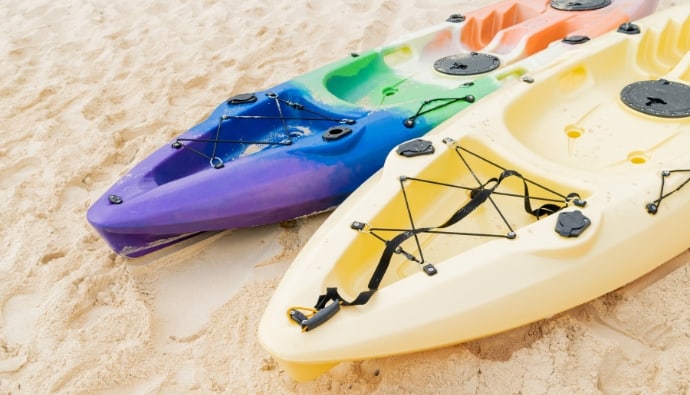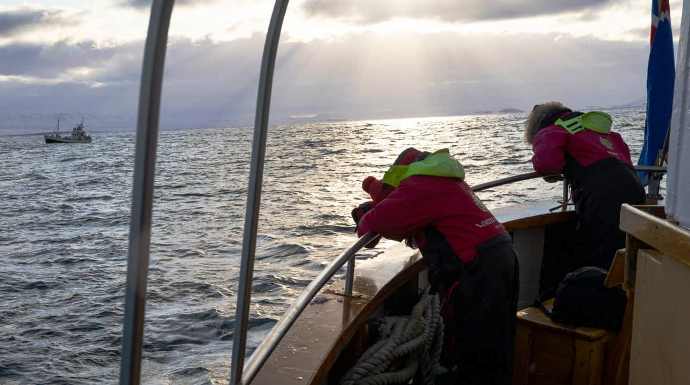Kayak fishing has become a popular favorite among outdoors enthusiasts, and yes, people do go kayak fishing in winter.

Kayaks allow you to maneuver and reach places that motorboats can’t, and they offer more stability than a canoe. Plus, you’re less likely to disturb the fish with a lot of churning and noise, and kayaking is better for the environment, too!
That said, anyone who goes out on the water in winter needs to take safety precautions and gear up the right way, and that includes kayak anglers. Here are some tips to keep in mind when you hit the water in cold weather.
Listen to more kayak fishing tips on the Cast & Spear Podcast
6 Tips for Cold Weather Kayak Fishing
1. Dress Right for the Occasion
Cold Weather Kayak Gear
While kayak fishing in any typical sunny weather, you should pack certain things, like a personal floatation device and sun protection for keeping your skin protected. But in winter, you’ll want to do things a little differently and have special winter fishing gear to help you battle the cold while still bagging your catch.
Winter Kayak Fishing Clothing
It’s essential for winter kayak fishing to dress in layers so your clothing can help you stay warm and dry.
Why do layers matter? The easy answer and functional convenience. As you set out early in the day, you’re going to be pretty cold. But as the day wears on, two things happen: the sun starts rising, but also, your body warms up from the effort of paddling (and hopefully, the effort of reeling in fish).
As you heat up, you’ll want to remove layers so that you don’t sweat. Sweating is great for helping your body maintain temperature, but you don’t want to be soaking wet in it when the evening comes and the air gets cool again. Any moisture, like your sweaty, wet clothing, is going to make you very cold very fast.
- Kayak Fishing Wetsuit
Bring a dry bag to keep your layers warm, no matter what happens. And consider that if the water is cold enough, you may even want to pack a wetsuit.
- Kayak Fishing Waders
It helps if your outer layer is as waterproof and breathable as you can manage. Gore-Tex rain bibs are a great part of waterproofing. Waders can be a great option, as well. Wear a belt around your waders so that if you do get wet, water won’t be as likely to get inside your waders.
2. Know the 120-Degree Rule
Just about everything worth doing carries a degree of risk, but some things are riskier than others. Going out on a boat in the winter means that the risk of hypothermia is very real.
However, the 120-degree rule can help you keep that risk to a minimum. If the sum of the water and air temperature together is at least 120 degrees, the risk is lower.
If you’re fishing at a location where the water and air temperature together are below 120 degrees, that’s when it’s time to consider a wetsuit or drysuit. This helps reduce the risk of hypothermia or frostbite if you enter the water.
Coming prepared and informed ensures your safety and elevates your chances of adapting to the situation.
3. Minimize Contact with the Water

Of course, another important way to minimize the risk of hypothermia and frostbite when kayak fishing in winter is simply to keep yourself out of the water as much as possible.
One great way to do that is to have the right kayak for the job. Kayaks with pontoon hulls are slower but a lot more stable than other types of kayaks. Most sit-on-top kayak and fishing kayaks already use pontoon hulls—after all, the last thing you want is for your boat to roll while you’re fighting a fish.
Another way to stay out of the water is to practice launching your kayak and docking it when the weather isn’t as cold. Most of your time in the water is going to come when you’re just setting out. Learning how to avoid that with a safe launch can make your whole day safer, not to mention cozier and more comfortable.
4. Pace Yourself
Be mindful of what your body does and listen to what it tells you. Careful layering isn’t the only way to avoid working up too much of a sweat.
Strong, fast paddling can be a good way to get your blood pumping, and your body warmed up, but you can have too much of a good thing, which can also be harmful. Take things slow, easy, and comfortably. If you’ve layered well, you’ll warm up before too long.
Besides, fishing is about slowing down and appreciating your surroundings. It’s hard to placidly reconnect with nature when you’re zipping across the water as fast as your arms can take you.
5. Bring a Buddy
Some people head out to the great outdoors to enjoy it for its own sake. Others see it as a chance to connect with the people they care about. Still, others use their time in nature for quiet moments alone.
No matter what your preference, though, it’s best not to venture out alone when the colder months settle in. Having another pair of hands and eyes can help you look out for (and overcome) any challenges that you may face on your trip.
Luckily, fishermen are some of the best people there are, and it’s easy to find like-minded people in your area.
6. Know Where You’re Going
Another great way to head off the hazards of winter waters is to plan your route out ahead of time. Even better if it’s a route that you’re already familiar with. You can recognize any changes to the water conditions or unusual circumstances that arise.
Make sure that at least one person back home knows where you’re going to be and when you plan on being back. And keep an eye on the weather. The National Oceanic and Atmospheric Administration (NOAA) is a great source of information.
And there’s so much more to consider than just temperature and precipitation. Being able to track wind speed can be a great help as you try to figure out what kind of weekend you’re in for.
Stay Safe, but Have Fun!
While you definitely need to plan things more carefully than normal, there’s no reason to let a little cold keep you from enjoying all that kayak fishing has to offer. As long as you plan ahead, dress carefully, stay dry, and keep being well-informed, you should be all set to have a wonderful time!
Author Bio: Derek Edwards is an avid outdoorsman based out of Southern California. You can follow along with his adventures over on his blog Outdoor with Derek.



 Facebook
Facebook YouTube
YouTube









